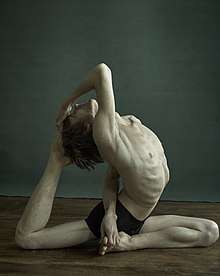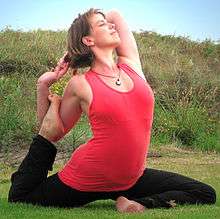Rajakapotasana

rajakapotasana or dove posture
Raja Kapotasana (Sanskrit: राजकपोतासन; IAST: Rāja Kapotāsana) or King Pigeon Pose[1] is an asana.
Etymology
The name comes from the Sanskrit words "raja" (राज) meaning "king", kapota (कपोत) meaning "pigeon"[1] and asana (आसन) meaning "posture" or "seat".[2]
Variations
Variations include:
- Eka Pada Rajakapotasana (एकपादराजकपोतासन) (One-Legged King Pigeon Pose)[3] and
- Salamba Kapotasana (Supported Pigeon Pose).[4]
Gallery
 In this variation, one of the feet hooks one of the arms.
In this variation, one of the feet hooks one of the arms. variation2..Sadhak Anshit
variation2..Sadhak Anshit
See also
References
- 1 2 "Eka Pada Raja Kapotasana - AshtangaYoga.info". Retrieved 2011-04-09.
- ↑ Sinha, S.C. (1 June 1996). Dictionary of Philosophy. Anmol Publications PVT. LTD. p. 18. ISBN 978-81-7041-293-9. Retrieved 9 April 2011.
- ↑ Kirk, Martin; Boon, Brooke (2006). Hatha yoga illustrated. Human Kinetics. p. 118. ISBN 978-0-7360-6203-9. Retrieved 9 April 2011.
- ↑ "Supported Pigeon Pose: Salamba Kapotasana :: Yoga.com". Archived from the original on 2011-06-09. Retrieved 2011-04-09.
Further reading
- Iyengar, B. K. S. (1 October 2005). Illustrated Light On Yoga. HarperCollins. ISBN 978-81-7223-606-9. Retrieved 9 April 2011.
- Saraswati, Swami Satyananda (1 August 2003). Asana Pranayama Mudra Bandha. Nesma Books India. ISBN 978-81-86336-14-4. Retrieved 9 April 2011.
- Saraswati, Swami Satyananda (January 2004). A Systematic Course in the Ancient Tantric Techniques of Yoga and Kriya. Nesma Books India. ISBN 978-81-85787-08-4. Retrieved 9 April 2011.
External links
This article is issued from
Wikipedia.
The text is licensed under Creative Commons - Attribution - Sharealike.
Additional terms may apply for the media files.